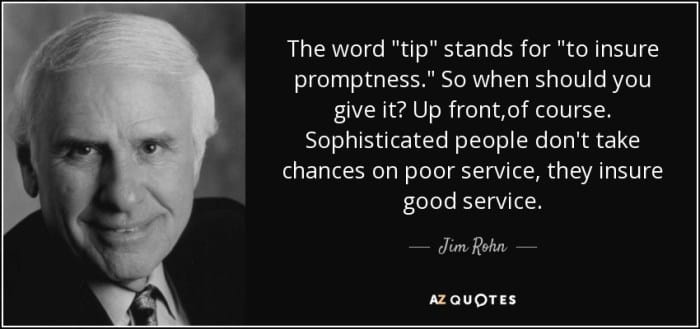In the realm of service industry interactions, tipping has become an ingrained practice, shaping customer experiences and livelihoods alike. Tipping practices vary across cultures and countries, influenced by historical, cultural, and economic factors. This article delves into the fascinating world of tipping, exploring its origins, interpretations, customer perceptions, service provider perspectives, economic implications, ethical considerations, alternative service models, industry trends, legal frameworks, and cross-cultural comparisons.
The acronym “TIPS” has been associated with tipping, sparking curiosity about its true meaning. Some believe it stands for “To Insure Prompt Service,” implying that a tip is a means to secure better service. Others interpret it as an acronym for “To Improve Personal Service,” emphasizing the role of tips in motivating service providers to deliver exceptional service.
Regardless of its exact origin, tipping has become an integral part of the service industry, shaping customer expectations and service provider experiences.
Service Industry Culture

Tipping, the act of giving a gratuity to someone who has provided a service, is a common practice in many cultures around the world. The history of tipping can be traced back to ancient times, when it was customary to give a small gift or token of appreciation to those who performed a service.
In the modern service industry, tipping has become an integral part of the compensation system for many workers. In some countries, such as the United States, tipping is expected and considered to be a way of showing appreciation for good service.
In other countries, such as Japan, tipping is considered to be rude and is generally not practiced.
Varying Norms and Expectations for Tipping Across Different Cultures and Countries
The norms and expectations for tipping vary widely across different cultures and countries. In some cultures, it is customary to tip only for exceptional service, while in others, it is expected to tip for even the most basic services.
- In the United States, it is customary to tip 15-20% for good service in restaurants, bars, and other service establishments. It is also common to tip taxi drivers, hotel staff, and other service workers.
- In Canada, the tipping culture is similar to that of the United States, although the expected tip amount is typically lower, at around 10-15%.
- In Europe, tipping is generally not as common as it is in the United States and Canada. In some countries, such as France and Italy, it is considered to be rude to tip. In other countries, such as Germany and Spain, it is customary to tip a small amount, typically around 5-10%.
- In Asia, tipping is generally not practiced. In some countries, such as Japan and China, it is considered to be insulting to tip a service worker.
Acronym Interpretation

The acronym “TIPS” has become synonymous with gratuities in the service industry. While it is commonly believed to stand for “To Insure Prompt Service,” the origin and evolution of this interpretation are not entirely clear.
One theory suggests that the acronym was coined in the early 20th century as a marketing strategy to encourage customers to leave gratuities. It is believed that restaurant owners and managers promoted the idea that tipping would ensure faster and better service, thus creating a positive association between tips and improved service.
Alternative Interpretations
Despite the widespread use of the “To Insure Prompt Service” interpretation, there are alternative explanations for the acronym “TIPS.” Some believe that it stands for “To Improve Personal Service,” emphasizing the role of gratuities in recognizing and rewarding individual service providers for their efforts.
Others suggest that “TIPS” is simply an acronym for “gratuities,” without any specific meaning attached to the individual letters. This interpretation is supported by the fact that the term “tip” has been used to refer to gratuities since the 17th century, long before the acronym “TIPS” came into use.
Customer Perception

The concept of tipping is deeply ingrained in the service industry, and customers’ perceptions of tipping play a significant role in shaping their experiences and the quality of service they receive.
There are several factors that influence customers’ decisions to tip or not, and the amounts they tip. These factors include:
Service Quality
The quality of service a customer receives is a major factor in determining whether they will tip and how much they will tip. Good service, such as attentive and friendly staff, prompt service, and a pleasant dining experience, is more likely to result in a tip than poor service.
Cultural and Societal Norms
Cultural and societal norms also play a role in tipping behavior. In some cultures, tipping is expected and considered a sign of appreciation for good service. In other cultures, tipping is less common or even considered rude.
Personal Beliefs and Values
Customers’ personal beliefs and values can also influence their tipping behavior. For example, some customers may tip more generously because they believe it is the right thing to do, while others may tip less or not at all because they believe that service workers should be paid a living wage by their employers.
Service Provider Perspective

In many service industries, tips play a significant role in determining the income of workers. For individuals working in low-wage jobs, tips can supplement their base salary and provide a crucial financial boost.
Tipping has a direct impact on job satisfaction and motivation among service providers. When customers show appreciation through tips, it validates the efforts and hard work of the service staff. This positive reinforcement can motivate them to provide exceptional service, creating a more enjoyable and rewarding work experience.
Impact on Service Quality
Tipping can also influence the overall quality of service. When customers know that their tips are directly tied to the level of service they receive, they are more likely to interact positively with service providers. This can lead to increased attentiveness, personalization, and overall satisfaction with the service experience.
Economic Implications
Tipping has a multifaceted impact on various economic aspects, including income distribution, tax revenue, and the overall economy. Understanding these economic implications is crucial for assessing the role of tipping in the service industry.
The practice of tipping can lead to income inequality, with service workers relying heavily on tips to supplement their base wages. This reliance can result in a significant income gap between tipped workers and other workers, particularly in countries where minimum wages are low.
Impact on Income Distribution
- Tipping can exacerbate income inequality, as service workers often rely on tips to supplement their base wages.
- In countries with low minimum wages, tipped workers may earn significantly less than workers in other industries.
- The reliance on tips can create a power imbalance between customers and service workers, potentially leading to exploitation.
Impact on Tax Revenue
- Tipped income is often underreported, leading to potential tax revenue loss for governments.
- The lack of transparency in tipping makes it challenging for tax authorities to accurately assess and collect taxes.
- Governments may implement policies to address underreporting of tipped income, such as mandatory electronic tip reporting or tip pooling.
Impact on the Overall Economy
- Tipping can stimulate economic activity, as service workers may spend their tips on goods and services, contributing to local economies.
- However, the reliance on tips can create uncertainty for service workers, making it difficult for them to plan their finances or access credit.
- Unstable income due to tipping may also discourage individuals from pursuing careers in the service industry.
Ethical Considerations

Tipping raises ethical concerns related to fairness, equality, and social responsibility. These concerns stem from the voluntary nature of tipping, which can lead to disparities in service quality and compensation for service providers.
One ethical consideration is the potential for discrimination and exploitation in tipping practices. In some cases, customers may tip based on factors unrelated to the quality of service, such as the race, gender, or appearance of the service provider. This can lead to unequal treatment and unfair compensation for service providers from marginalized groups.
Economic Implications
- Tipping can create a situation where service providers rely on tips to supplement their income, rather than being paid a fair wage by their employer. This can lead to a cycle of low wages and poverty for service workers.
- Tipping can also lead to a lack of transparency in pricing, as customers may not be aware of the actual cost of the service they are receiving. This can make it difficult for customers to make informed decisions about how much to tip.
Social Implications
- Tipping can create a sense of obligation and pressure on customers to tip, even when they are not satisfied with the service they have received. This can lead to feelings of guilt or resentment, and can undermine the customer’s experience.
- Tipping can also create a sense of entitlement among service providers, who may come to expect tips as a matter of course. This can lead to a decline in the quality of service, as service providers may become less motivated to provide excellent service if they are not receiving tips.
Conclusion
The ethical implications of tipping are complex and multifaceted. There is no easy answer to the question of whether or not tipping is fair or ethical. However, it is important to be aware of the potential ethical issues associated with tipping so that we can make informed decisions about how we tip.
Alternative Service Models
Tipping has been a long-standing practice in the service industry, but it is not the only way to compensate workers. In recent years, there has been a growing interest in alternative service models that do not rely on tipping.
These models offer several potential advantages, including:
- Increased transparency: Customers know exactly how much they will be paying for service, and there is no need to worry about calculating a tip.
- Reduced pressure on customers: Customers do not feel obligated to tip, which can be a source of anxiety for some people.
- More equitable pay for workers: Workers are paid a fixed wage or salary, which provides a more stable income than relying on tips.
However, alternative service models also have some disadvantages:
- Lower overall earnings for workers: In some cases, workers may earn less in tips than they would under a traditional tipping system.
- Reduced flexibility for customers: Customers cannot reward good service with a larger tip, which can lead to less attentive service.
- Potential for increased costs for customers: Restaurants and other businesses may need to raise prices to cover the cost of paying workers a higher wage or salary.
Overall, the decision of whether to adopt an alternative service model is a complex one. There are both advantages and disadvantages to consider, and the best model for a particular business will depend on its specific circumstances.
Fixed-Price Pricing
Fixed-price pricing is a model in which customers pay a set price for a meal or service, regardless of the quality of service they receive. This model is common in many countries around the world, and it is becoming increasingly popular in the United States.
There are several advantages to fixed-price pricing:
- Increased transparency: Customers know exactly how much they will be paying for service, and there is no need to worry about calculating a tip.
- Reduced pressure on customers: Customers do not feel obligated to tip, which can be a source of anxiety for some people.
- More equitable pay for workers: Workers are paid a fixed wage or salary, which provides a more stable income than relying on tips.
However, fixed-price pricing also has some disadvantages:
- Lower overall earnings for workers: In some cases, workers may earn less in tips than they would under a traditional tipping system.
- Reduced flexibility for customers: Customers cannot reward good service with a larger tip, which can lead to less attentive service.
- Potential for increased costs for customers: Restaurants and other businesses may need to raise prices to cover the cost of paying workers a higher wage or salary.
Industry Trends
The tipping landscape is undergoing a transformative shift, driven by technological advancements and changing consumer preferences. This section explores emerging trends and innovations that are reshaping the way gratuities are given and received.
The proliferation of digital payment options has paved the way for seamless and convenient tipping experiences. Customers can now effortlessly add tips to their bills using credit cards, debit cards, or mobile payment apps. This eliminates the need for physical cash, enhancing the overall payment process for both customers and service providers.
Mobile Payment Options
Mobile payment options, such as Apple Pay, Google Pay, and Samsung Pay, have gained immense popularity in recent years. These platforms allow customers to make payments quickly and securely using their smartphones. The integration of tipping features within these apps further streamlines the process, enabling customers to add gratuities with just a few taps.
The convenience and ease of use offered by mobile payment options are driving their widespread adoption. As more customers embrace these technologies, the reliance on cash tips is expected to decline, leading to a more digitalized tipping ecosystem.
Tip-Pooling Systems
Tip-pooling systems have emerged as a means to distribute tips more equitably among service staff. In these systems, all tips received by a business are pooled together and then divided equally among employees, regardless of their individual sales or customer interactions.
Tip-pooling can address concerns about unfair tip distribution and ensure that all employees are compensated fairly for their contributions to the business. It also promotes teamwork and collaboration among staff members, as they work together to provide excellent customer service.
Potential Impact of Trends on the Future of Tipping
The adoption of digital tipping methods and the implementation of tip-pooling systems are likely to have a significant impact on the future of tipping. These trends could lead to a decline in cash tips, a more equitable distribution of gratuities among service staff, and an overall improvement in the customer experience.
As technology continues to evolve, it is possible that new and innovative tipping practices will emerge. These advancements could further transform the tipping landscape, creating a more seamless and efficient system for both customers and service providers.
Legal and Regulatory Framework

The legal and regulatory framework surrounding tipping practices varies across different jurisdictions. Governments and labor laws play a crucial role in regulating these practices, aiming to protect both employees and consumers.
Government Agencies
Government agencies, such as labor departments or revenue authorities, are responsible for enforcing regulations related to tipping. They may set minimum wage standards, determine whether tips can be counted as part of an employee’s wages, and establish guidelines for tip pooling or service charges.
Labor Laws
Labor laws often address issues related to tipping, including the distribution of tips among employees, the prohibition of tip-pooling in certain circumstances, and the right of employees to refuse tips.
Legal Challenges
The legality of tipping practices has been subject to legal challenges in various jurisdictions. Some cases have focused on the classification of tips as wages, while others have examined the rights of employees to receive tips.
Consumer Protection
Regulatory frameworks also aim to protect consumers from deceptive or unfair tipping practices. This may include ensuring that service charges are clearly displayed on menus or receipts, and that consumers are not misled about the intended use of tips.
Cross-Cultural Comparisons

Tipping practices vary significantly across different countries and cultures, reflecting diverse social norms, economic conditions, and historical contexts. Understanding these variations provides insights into the complexities of service industry dynamics and customer-provider interactions.
In some cultures, tipping is customary and expected, while in others, it is considered unnecessary or even offensive. These differences can be attributed to factors such as the level of wages paid to service workers, the cost of living, and cultural values surrounding the concept of service.
Similarities and Differences in Tipping Behaviors
Despite cultural variations, some similarities in tipping behaviors can be observed across different countries.
- Gratitude: Tipping is often seen as a way to express gratitude for good service.
- Discretion: The amount of tip is typically left to the discretion of the customer.
- Service Quality: The quality of service received often influences the amount of tip given.
However, there are also notable differences in tipping behaviors.
- Mandatory vs. Voluntary: In some countries, tipping is mandatory, while in others, it is voluntary.
- Tip Amount: The average tip amount varies significantly across countries.
- Service Types: The types of services for which tipping is customary also differ.
Factors Contributing to Variations in Tipping Behaviors
Several factors contribute to the variations in tipping behaviors across cultures.
- Economic Conditions: The level of wages paid to service workers and the cost of living influence tipping practices.
- Cultural Values: Cultural values surrounding service, social hierarchy, and reciprocity shape tipping norms.
- Tourism: The presence of a significant tourism industry can impact tipping behaviors.
- Government Regulations: Government regulations and policies related to tipping can influence tipping practices.
Understanding these factors is crucial for service providers and customers to navigate the complexities of tipping practices in different cultural contexts.
Final Thoughts

As we navigate the ever-evolving landscape of tipping practices, it is essential to consider the diverse perspectives and implications involved. Tipping can be a means of expressing gratitude, a way to supplement low wages, or a potential source of discrimination and exploitation.
Alternative service models, such as fixed-price pricing or service charges, offer potential solutions to address some of the challenges associated with tipping. Ultimately, the future of tipping will likely be shaped by a combination of cultural norms, economic factors, and technological advancements, leading to a dynamic and evolving service industry landscape.
Frequently Asked Questions
Is tipping mandatory?
Tipping is generally not mandatory, but it is customary in many cultures and countries. The amount of tip is typically discretionary and varies depending on the quality of service, local customs, and personal preferences.
What are the benefits of tipping?
Tipping can motivate service providers to deliver better service, increase job satisfaction, and supplement low wages. For customers, tipping can be a way to express gratitude and appreciation for good service.
Are there any ethical concerns about tipping?
Tipping can raise ethical concerns related to fairness, equality, and social responsibility. It can create a power imbalance between customers and service providers and may lead to discrimination or exploitation. Additionally, tipping can contribute to income inequality, as it is often distributed unevenly among service providers.
What are some alternative service models to tipping?
Alternative service models include fixed-price pricing, service charges, and employee profit-sharing. These models aim to provide fair compensation to service providers without relying on customer tips. However, they may also impact customer expectations and service quality.



